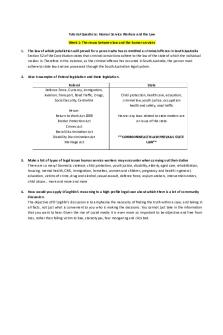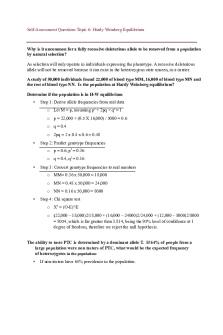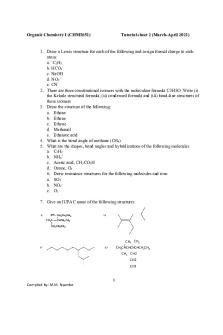MCQ6 - Tutorial PDF

| Title | MCQ6 - Tutorial |
|---|---|
| Author | Reece Slocombe |
| Course | Introduction To Financial Derivatives |
| Institution | City University London |
| Pages | 4 |
| File Size | 51.8 KB |
| File Type | |
| Total Downloads | 59 |
| Total Views | 145 |
Summary
Tutorial...
Description
1. Which of the following creates a bull spread? A. Buy a low strike price call and sell a high strike price call B. Buy a high strike price call and sell a low strike price call! C. Buy a low strike price call and sell a high strike price put! D. Buy a low strike price put and sell a high strike price call! A bull spread is created by buying a low strike call and selling a high strike call. Alternatively, it can be created by buying a low strike put and selling a high strike put! 2. Which of the following creates a bear spread? A. Buy a low strike price call and sell a high strike price call! B. Buy a high strike price call and sell a low strike price call C. Buy a low strike price call and sell a high strike price put! D. Buy a low strike price put and sell a high strike price call! A bear spread is created by buying a high strike call and selling a low strike call. Alternatively, it can be created by buying a high strike put and selling a low strike put.! 3. Which of the following creates a bull spread? A. Buy a low strike price put and sell a high strike price put B. Buy a high strike price put and sell a low strike price put! C. Buy a high strike price call and sell a low strike price put! D. Buy a high strike price put and sell a low strike price call! A bull spread is created by buying a low strike call and selling a high strike call. Alternatively, it can be created by buying a low strike put and selling a high strike put.! 4. Which of the following creates a bear spread? A. Buy a low strike price put and sell a high strike price put! B. Buy a high strike price put and sell a low strike price put C. Buy a high strike price call and sell a low strike price put! D. Buy a high strike price put and sell a low strike price call! A bear spread is created by buying a high strike call and selling a low strike call.! Alternatively, it can be created by buying a high strike put and selling a low strike put.! 5. What is the number of different option series used in creating a butterfly spread? A. 1! B. 2 ! C. 3 ! D. 4! Three different options all with the same maturity are involved in creating a butterfly spread. The strike prices are usually equally spaced. The creator buys the low strike option, buys the high strike option, and sells two of the intermediate strike option!
6. A stock price is currently $23. A reverse (i.e short) butterfly spread is created from options with strike prices of $20, $25, and $30. Which of the following is true? A. The gain when the stock price is greater that $30 is less than the gain when the stock price is less than $20! B. The gain when the stock price is greater that $30 is greater than the gain when the stock price is less than $20! C. The gain when the stock price is greater that $30 is the same as the gain when the stock price is less than $20 D. It is incorrect to assume that there is always a gain when the stock price is greater than $30 or less than $20! The gain from a very high stock price or a very low stock price is the same. Suppose calls are used. In the case of a very low stock price none are exercised and the gain is c1+c3−2c2 from the option premium. In the case of a very high stock price all options are exercised. The net payoff is zero and the gain is the same! 7. Which of the following is correct? A. A calendar spread can be created by buying a call and selling a put when the strike! prices are the same and the times to maturity are different! B. A calendar spread can be created by buying a put and selling a call when the strike! prices are the same and the times to maturity are different! C. A calendar spread can be created by buying a call and selling a call when the strike! prices are different and the times to maturity are different! D. A calendar spread can be created by buying a call and selling a call when the strike prices are the same and the times to maturity are different A calendar spread is created by buying an option with one maturity and selling an option with another maturity when the strike prices are the same and the option types (calls or puts) are the same.! 8. What is a description of the trading strategy where an investor sells a 3-month call option and buys a one-year call option, where both options have a strike price of $100 and the underlying stock price is $75? A. Neutral Calendar Spread! B. Bullish Calendar Spread C. Bearish Calendar Spread! D. None of the above! This is a bullish calendar spread because a big increase in the stock price between three months and one year is necessary for the trading strategy to be profitable.! 9. Which of the following is correct? A. A diagonal spread can be created by buying a call and selling a put when the strike! prices are the same and the times to maturity are different! B. A diagonal spread can be created by buying a put and selling a call when the strike! prices are the same and the times to maturity are different! C. A diagonal spread can be created by buying a call and selling a call when the strike pricesare different and the times to maturity are different D. A diagonal spread can be created by buying a call and selling a call when the strike prices! are the same and the times to maturity are different! Both the strike prices and times to maturity are different in a diagonal spread.!
10. Which of the following is true of a box spread? A. It is a package consisting of a bull spread and a bear spread! B. It involves two call options and two put options! C. It has a known value at maturity! D. All of the above A, B, and C are all true.! 11. How can a straddle be created? A. Buy one call and one put with the same strike price and same expiration date B. Buy one call and one put with different strike prices and same expiration date! C. Buy one call and two puts with the same strike price and expiration date! D. Buy two calls and one put with the same strike price and expiration date! A straddle consists of one call and one put where the strike price and time to maturity are the same. It has a V-shaped payoff! 12. How can a strip trading strategy be created? A. Buy one call and one put with the same strike price and same expiration date! B. Buy one call and one put with different strike prices and same expiration date! C. Buy one call and two puts with the same strike price and expiration date D. Buy two calls and one put with the same strike price and expiration date! A strip consists of one call and two puts with the same strike price and time to maturity.! 13. How can a strap trading strategy be created? A. Buy one call and one put with the same strike price and same expiration date! B. Buy one call and one put with different strike prices and same expiration date! C. Buy one call and two puts with the same strike price and expiration date! D. Buy two calls and one put with the same strike price and expiration date A strap consists of two calls and one put with the same strike price and time to maturity.! 14. How can a strangle trading strategy be created? A. Buy one call and one put with the same strike price and same expiration date! B. Buy one call and one put with different strike prices and same expiration date C. Buy one call and two puts with the same strike price and expiration date! D. Buy two calls and one put with the same strike price and expiration date! A straddle consists of one call and one put where the times to maturity are the same but the call strike price is greater than the put strike price.! 15. Which of the following describes a protective put? A. A long put option on a stock plus a long position in the stock B. A long put option on a stock plus a short position in the stock! C. A short put option on a stock plus a short call option on the stock! D. A short put option on a stock plus a long position in the stock! A protective put consists of a long put plus the stock. The holder of the put owns the stock that might become deliverable.! 16. Which of the following describes a covered call? A. A long call option on a stock plus a long position in the stock! B. A long call option on a stock plus a short put option on the stock! C. A short call option on a stock plus a short position in the stock! D. A short call option on a stock plus a long position in the stock A covered call consists of a short call plus a long position in the stock. Then if the call is exercised the owner of the position has the stock ready to deliver if the other side exercises the call.!
17. When the interest rate is 5% per annum with continuous compounding, which of the following creates a principal protected note worth $1000? A. A one-year zero-coupon bond plus a one-year call option worth about $59! B. A one-year zero-coupon bond plus a one-year call option worth about $49 C. A one-year zero-coupon bond plus a one-year call option worth about $39! D. A one-year zero-coupon bond plus a one-year call option worth about $29! A one-year zero-coupon bond is worth 1000e-0.05×1 or about $951. This leaves 1000−951 = $49 for buying the option.! 18. A trader creates a long butterfly spread from options with strike prices $60, $65, and $70 by trading a total of 400 options. The options are worth $11, $14, and $18. What is the maximum net gain (after the cost of the options is taken into account)? A. $100! B. $200 ! C. $300 ! D. $400 The butterfly spread involves buying 100 options with strike prices $60 and $70 and selling 200 options with strike price $65. The maximum gain is when the stock price equals the middle strike price, $65. The payoffs from the options are then, $500, 0, and 0, respectively. The total payoff is $500. The cost of setting up the butterfly spread is 11×100+18×100−14×200 = $100. The gain is 500−100 or $400.! 19. A trader creates a long butterfly spread from options with strike prices $60, $65, and $70 by trading a total of 400 options. The options are worth $11, $14, and $18. What is the maximum net loss (after the cost of the options is taken into account)? A. $100 B. $200 ! C. $300 ! D. $400! The butterfly spread involves buying 100 options with strike prices $60 and $70 and selling 200 options with strike price $65. The maximum loss is when the stock price is less than $60 or greater than $70. The total payoff is then zero. The cost of setting up the butterfly spread is 11×100+18×100−14×200 = $100. The loss is therefore $100! 20. Six-month call options with strike prices of $35 and $40 cost $6 and $4, respectively. What is the maximum gain when a bull spread is created by trading a total of 200 options? A. $100 ! B. $200 ! C. $300 D. $400! The bull spread involves buying 100 calls with strike $35 and selling 100 calls with strike price $40. The cost is 6×100−4×100=$200. The maximum payoff (when the stock price is greater than or equal to $40 is $500. The maximum gain is therefore 500 −200 = $300....
Similar Free PDFs

MCQ6 - Tutorial
- 4 Pages

Tutorial
- 17 Pages

Tutorial-4 - Tutorial Problems
- 3 Pages

BFW2401-Tutorial 8 - Tutorial
- 2 Pages

Tutorial
- 2 Pages

203-tutorial-9 - Tutorial 9
- 4 Pages

Radiation tutorial
- 3 Pages

Tutorial Questions
- 15 Pages

VisiRule Tutorial
- 42 Pages

Tutorial 1
- 4 Pages

Tutorial-2
- 1 Pages

Genetics Tutorial
- 5 Pages
Popular Institutions
- Tinajero National High School - Annex
- Politeknik Caltex Riau
- Yokohama City University
- SGT University
- University of Al-Qadisiyah
- Divine Word College of Vigan
- Techniek College Rotterdam
- Universidade de Santiago
- Universiti Teknologi MARA Cawangan Johor Kampus Pasir Gudang
- Poltekkes Kemenkes Yogyakarta
- Baguio City National High School
- Colegio san marcos
- preparatoria uno
- Centro de Bachillerato Tecnológico Industrial y de Servicios No. 107
- Dalian Maritime University
- Quang Trung Secondary School
- Colegio Tecnológico en Informática
- Corporación Regional de Educación Superior
- Grupo CEDVA
- Dar Al Uloom University
- Centro de Estudios Preuniversitarios de la Universidad Nacional de Ingeniería
- 上智大学
- Aakash International School, Nuna Majara
- San Felipe Neri Catholic School
- Kang Chiao International School - New Taipei City
- Misamis Occidental National High School
- Institución Educativa Escuela Normal Juan Ladrilleros
- Kolehiyo ng Pantukan
- Batanes State College
- Instituto Continental
- Sekolah Menengah Kejuruan Kesehatan Kaltara (Tarakan)
- Colegio de La Inmaculada Concepcion - Cebu



